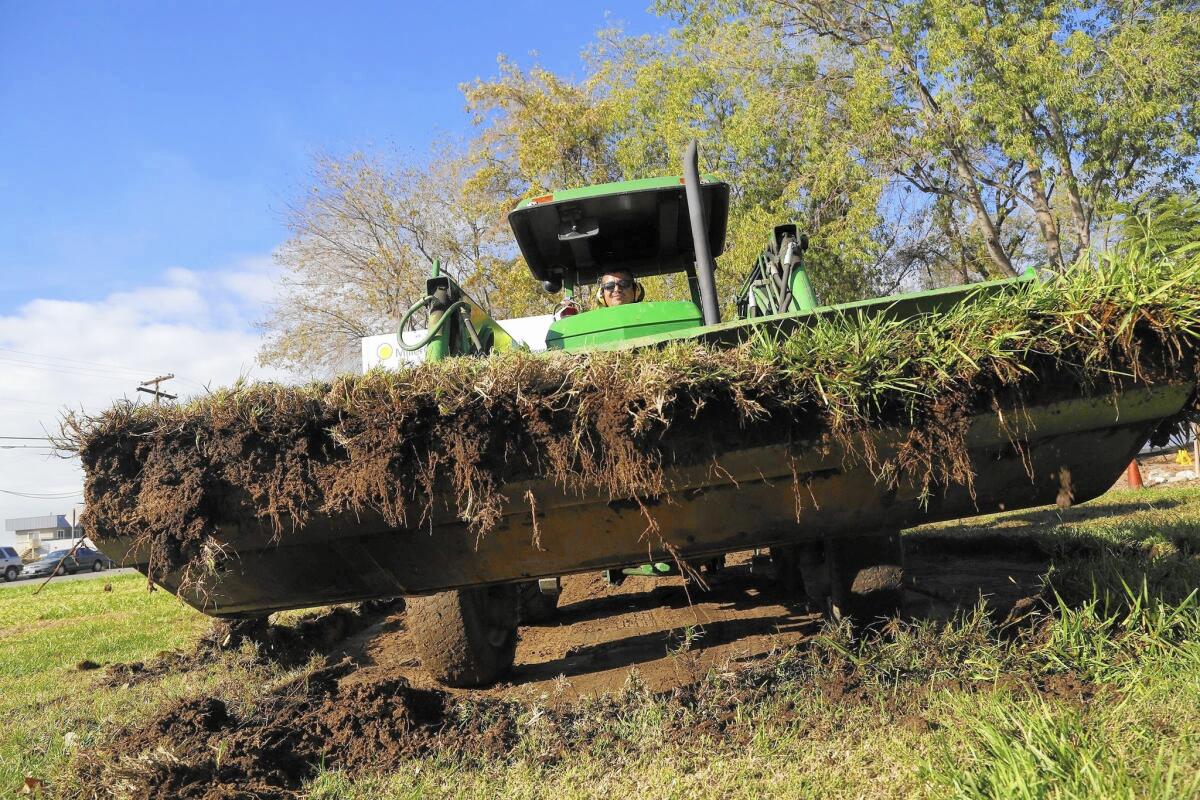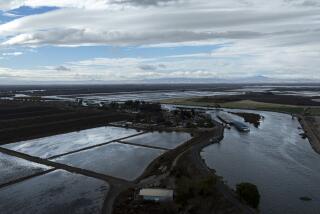Southland water district ends popular lawn-removal rebate program

- Share via
When Gov. Jerry Brown called on drought-weary Californians to reconsider their love of thirsty, nonnative landscaping, some businesses and homeowners responded by tearing out their once-cherished lawns.
Additional motivation for swapping out grass for drought-resistant plants came in the form of cash rebates offered by local governments and water agencies.
Yet barely a month after officials at the Metropolitan Water District of Southern California approved an additional $350 million in rebate funds, they ended the program Thursday. All of the money, they said, was spoken for.
“We didn’t predict just how popular turf rebates would become,” said MWD General Manager Jeffrey Kightlinger.
The news sent some local water agencies and governments scrambling for ways to keep rebates alive, if at a less generous level.
Some said the development was an indication that Californians are indeed altering their behavior, as well as their landscaping preferences, in the face of severe drought.
“The timing was right for turf removal programs,” said Brent Haddad, director of the Center for Integrated Water Research at UC Santa Cruz. “We’re developing a new aesthetic for open space in California and moving away from the ideal of the green grasses of Kentucky.”
The MWD had set aside a total of $450 million in rebates. Of those funds, roughly $340 million was earmarked for lawn removal and $110 million was for rebates on drought-friendly appliances such as water-saving toilets.
MWD officials said they knew the money would eventually run out, but they never dreamed it would so quickly.
Officials say the program will help to fund the removal of up to 170 million square feet of turf, three times the statewide goal Brown set in a historic executive order that also sought to cut urban water use by 25%.
MWD directors will get an update on the program next week, “but we have no indication that they will add more money,” said MWD spokeswoman Sherita Coffelt.
The earliest the board might consider boosting funding would be sometime in 2016 when officials begin planning for the 2016-17 fiscal year, she said.
Still, between 20% and 30% of people who apply for turf rebates don’t follow through. So interested residents can get on a waiting list and still have a chance, Coffelt said.
All told, officials believe Southern California will save about 26 billion gallons of water a year, enough to serve 160,000 households annually.
Bill McDonnell, an MWD water efficiency manager, said the massive spending on the program was justified.
“It started the huge snowball down the hill,” he said. “If we had done $5 million in turf removal, you wouldn’t be writing an article and it wouldn’t be on NPR or the TV. Our service area is so big, that amount of impact wouldn’t have been seen. We needed to do something big and something impactful to start the discussion and start the change.”
The news had local water districts scrambling Thursday to maintain their rebate programs.
For the last several months, the Los Angeles Department of Water and Power has supplemented MWD’s $2-per-square-foot rebate money with up to $1.75 of its own.
The DWP “is working quickly on a plan to continue the portion of the rebate that was funded through its own water conservation budget … while at the same time not jeopardizing other critical water programs,” a department spokeswoman said in a statement.
Long Beach, which has already converted 2 million square feet of grass to drought-tolerant landscapes, pledged to continue providing residential rebates of $2.50 per square foot — down from the $3.50 that had been offered with the help of MWD’s funding.
In south Orange County, the board of the Santa Margarita Water District “recognized that the bank was getting emptied” and set aside $500,000 for turf removal rebates in May, said spokesman Jonathan Volzke.
The rebate program has been “such a great awareness campaign for us,” he said. “It really is a great tool for keeping the drought in front of people.... It reinforces the idea that we need to live different in California now.”
Still, he added, “We probably shouldn’t have printed so many brochures.”
But some water suppliers that had relied solely on MWD’s rebate money had to shut down their programs altogether.
The Las Virgenes Municipal Water District, which serves the affluent cities of Agoura Hills, Calabasas, Hidden Hills and Westlake Village, had to say goodbye to its popular “Mow No Mow” turf program. Officials said more than 1,000 residential customers — many with large lots — removed more than 40 acres of lawn with the help of about $3.4 million in rebates.
“What I’m kind of sad about — we gained so much momentum, then we hit the wall, and it stopped,” said Carlos Reyes, director of resource conservation and public outreach for the district. “We’re hoping people will do this without the incentive.”
Twitter: @bymattstevens
Twitter: @montemorin
More to Read
Sign up for Essential California
The most important California stories and recommendations in your inbox every morning.
You may occasionally receive promotional content from the Los Angeles Times.












